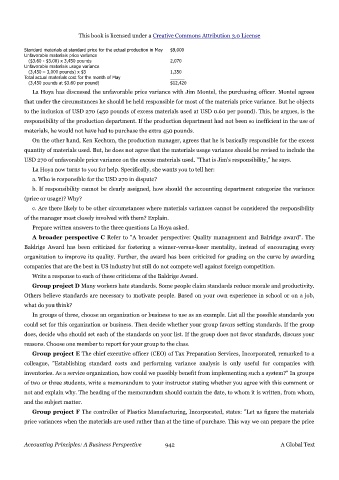Page 941 - Accounting Principles (A Business Perspective)
P. 941
This book is licensed under a Creative Commons Attribution 3.0 License
Standard materials at standard price for the actual production in May $9,000
Unfavorable materials price variance
($3.60 - $3.00) x 3,450 pounds 2,070
Unfavorable materials usage variance
(3,450 – 3,000 pounds) x $3 1,350
Total actual materials cost for the month of May
(3,450 pounds at $3.60 per pound) $12,420
La Hoya has discussed the unfavorable price variance with Jim Montel, the purchasing officer. Montel agrees
that under the circumstances he should be held responsible for most of the materials price variance. But he objects
to the inclusion of USD 270 (450 pounds of excess materials used at USD 0.60 per pound). This, he argues, is the
responsibility of the production department. If the production department had not been so inefficient in the use of
materials, he would not have had to purchase the extra 450 pounds.
On the other hand, Ken Kechum, the production manager, agrees that he is basically responsible for the excess
quantity of materials used. But, he does not agree that the materials usage variance should be revised to include the
USD 270 of unfavorable price variance on the excess materials used. "That is Jim's responsibility," he says.
La Hoya now turns to you for help. Specifically, she wants you to tell her:
a. Who is responsible for the USD 270 in dispute?
b. If responsibility cannot be clearly assigned, how should the accounting department categorize the variance
(price or usage)? Why?
c. Are there likely to be other circumstances where materials variances cannot be considered the responsibility
of the manager most closely involved with them? Explain.
Prepare written answers to the three questions La Hoya asked.
A broader perspective C Refer to "A broader perspective: Quality management and Balridge award". The
Baldrige Award has been criticized for fostering a winner-versus-loser mentality, instead of encouraging every
organization to improve its quality. Further, the award has been criticized for grading on the curve by awarding
companies that are the best in US industry but still do not compete well against foreign competition.
Write a response to each of these criticisms of the Baldrige Award.
Group project D Many workers hate standards. Some people claim standards reduce morale and productivity.
Others believe standards are necessary to motivate people. Based on your own experience in school or on a job,
what do you think?
In groups of three, choose an organization or business to use as an example. List all the possible standards you
could set for this organization or business. Then decide whether your group favors setting standards. If the group
does, decide who should set each of the standards on your list. If the group does not favor standards, discuss your
reasons. Choose one member to report for your group to the class.
Group project E The chief executive officer (CEO) of Tax Preparation Services, Incorporated, remarked to a
colleague, "Establishing standard costs and performing variance analysis is only useful for companies with
inventories. As a service organization, how could we possibly benefit from implementing such a system?" In groups
of two or three students, write a memorandum to your instructor stating whether you agree with this comment or
not and explain why. The heading of the memorandum should contain the date, to whom it is written, from whom,
and the subject matter.
Group project F The controller of Plastics Manufacturing, Incorporated, states: "Let us figure the materials
price variances when the materials are used rather than at the time of purchase. This way we can prepare the price
Accounting Principles: A Business Perspective 942 A Global Text

